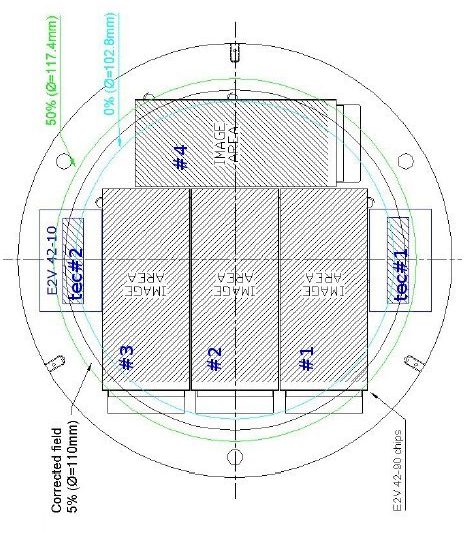Focal Plane Layout
The LBC focal planes consist of four EEV42-90 CCDs (2048 x 4608 pixels, 13.5 microns x 13.5 microns per pixel) arranged such that three of the chips are butted along their long edges, with the fourth chip rotated counterclockwise by 90 degrees and centered along the top of the other CCDs. The three CCDs that are arranged with their long edges together are numbered from right to left, chip #1 to chip #3, the top rotated CCD is chip #4. There are two technical chips, one on either side of the focal plane array. The one closest to chip #1 is used for guiding and the one closest to chip #3 is set 0.8 mm below the focal plane to produce out-of-focus pupil images which are analyzed automatically to adjust focus in between exposures. Now that TMS is operating, its more precise focus adjustments override those from chip #3.
The first 2 images below show the relative positions of the four science and two technical detectors for LBC Blue (left) and LBC Red (right). The circles denote radii of the corrected fields (black circles) and percentage vignetting at a given radius (blue, green and red circles).
At the f/1.47 LBC focus, the focal plane scale is 16.9 arcsec/mm, and, thus, the average pixel scale for both LBC Blue and LBC Red is 0.2255 arcsec/pixel. Each CCD covers approximately 7.8 arcmin x 17.6 arcmin, with gaps between the chips of ~18 arcseconds. The science field of view is approximately 25 arcmin x 23 arcmin. The astrometrically-corrected LBCB and LBCR science and tech chip images of the galaxy IC 342 further illustrate the relative positions and scale.
The rotation centers are located on chip 2, at [1035,2924] for LBC-Blue and [1078,2913] for LBC-Red.
 |
 |


